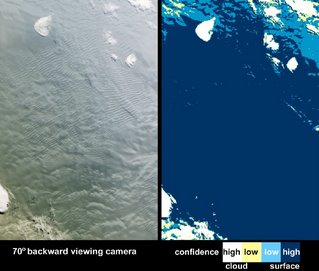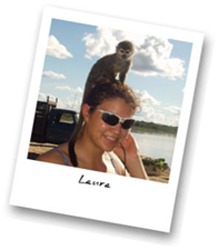Sastrugi
In TK's Glen Alps trail report yesterday he introduced me to a new snow word which I wanted, in turn, to introduce to you. It's not very often that I have to use a dictionary when I'm reading the trail report so this was a particularly exciting find.
Sastrugi are the snow dunes that get formed by the wind. The word comes from the Russian word zastrugi which does not have a singular version but us English speakers have latinized it to have the singular sastruga. They're like sand dunes but while sand dunes are perpendicular to the prevailing wind direction, the sastrugi ridges run parallel to the prevailing wind.
This is a satellite image of some huge sastrugi on Antarctica. The panel on the right shows that the ripples are in the ice surface and not in the cloud cover. (Click on the image to see it enlarged.)

click HERE to go to location of the original photo.
Sastrugi are the snow dunes that get formed by the wind. The word comes from the Russian word zastrugi which does not have a singular version but us English speakers have latinized it to have the singular sastruga. They're like sand dunes but while sand dunes are perpendicular to the prevailing wind direction, the sastrugi ridges run parallel to the prevailing wind.
This is a satellite image of some huge sastrugi on Antarctica. The panel on the right shows that the ripples are in the ice surface and not in the cloud cover. (Click on the image to see it enlarged.)

click HERE to go to location of the original photo.


4 Comments:
Good to hear that you finally found an English word from Russian roots!
If you and Serge want to ski at Glen Alps tomorrow morning, let me know...
Hey Laura, I heard there was sastrugi talk going on over here … so I dropped by. I’ve always considered sastrugi the “anti snow drift”. Whereas drifts, cornices and wind bells are caused by the accumulation of snow, sastrugi is mostly caused by the erosion of snow. Often snow drifts become sastrugi. You see a lot of this all over the open areas of Western Alaska and the North Slope. There is a snowfall, wind forms drifts, the drifts harden and then high winds sculpt, by erosion, the drifts. Of course this erosion causes more drifting and due to the wind channeling of the drifts, the sastrugi ends up in a parallel plane to the wind. Speaking of the North Slope, up there you can ski up and over sastrugi covered pingos … that might be another new word for you. And one of my favorite snow words: graupel.
Last winter there was lots of North wind ripping up the snowcover over much of Alaska. This caused lots of sastrugi on exposed ridges around here. If you look at my skiing pictures web page from last year, crust.outlookalaska.com/Skiing2007, you can see a close-up picture of sastrugi. If you scroll down to the “Chugach Crust Arches” picture, that’s actually a shot of some sastrugi. In this case it’s sastrugi that was eroded through to create a “sastrugi arch”. It’s about 16 inches high and the skiers on it were Photoshop’ed into the image, but shhhhh don’t tell anyone that!!! ;-) If you scroll down to the Little Mount Susitna section – the video shows skiing across monster sastrugi.
Yep – you are living in a place where there is lots of stuff with cool names. With names like: moulin, cwm (I spelled this right), cirque, serac, arête, tor, pluton, solifluction lobe, glacial erratic … Hey … where’s that dictionary?!! ;-) Ski fast! Tim
time kelley's photos
(for my readers who are too lazy to cut and paste)
tim- thanks for stopping by and educating me some more!
I did have to look up pingo, moulin, cwm, tor, pluton, & solifluction lobe. Graupel is one of my fav snow words also.
I have been thinking about making a Snow Vocab page as part of my site... I see that I will definitely have to consult you!
Post a Comment
<< Home